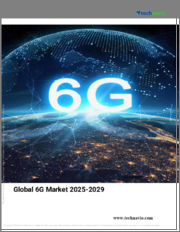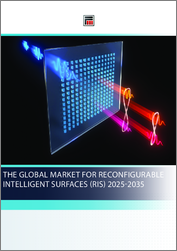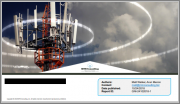
|
시장보고서
상품코드
1634257
일본의 6G 시장(2024-2031년)Japan 6G Market - 2024 - 2031 |
||||||
일본의 6G 시장은 2023년에 3억 3,810만 달러에 달하고, 2031년에는 967억 4,000만 달러에 이를 것으로 예측되며, 예측 기간 2024-2031년의 CAGR은 102.80%를 나타낼 전망입니다.
일본은 6G를 선도하는 국가가 되고자 합니다. Beyond 5G(6G)는 2030년대에 도입될 차세대 정보통신 인프라로, 모든 산업 및 사회 활동의 기반이 될 것으로 예상됩니다. Beyond 5G(6G)는 기존 이동통신의 단순한 확장이 아니라 유선, 무선, 육상, 해상, 공중, 우주를 아우르는 통합 네트워크입니다.
6G 시장은 통신 기술의 발전, 초고속 연결에 대한 수요 증가, 다양한 산업에 걸친 AI와 IoT의 통합에 힘입어 혁신적인 성장을 이룰 것으로 전망됩니다. 테라헤르츠(THz) 통신, 재구성 가능한 지능형 표면(RIS), 양자 통신과 같은 새로운 트렌드는 네트워크 기능을 재정의하여 비교할 수 없는 속도, 안정성, 보안을 제공할 것입니다.
스마트 기기의 확산과 증강현실(AR), 가상현실(VR), 확장현실(XR)과 같은 몰입형 기술의 부상은 6G에 대한 수요를 더욱 촉진하고 있습니다. 연구 개발에 대한 전 세계적인 투자와 정부, 학계, 민간 기업 간의 협력 정책은 이 분야의 성장 모멘텀을 강조합니다. 또한 지속 가능성, 에너지 효율성, 지상파 및 비지상파 네트워크의 원활한 통합에 중점을 둔 6G는 의료, 자동차, 엔터테인먼트 등의 산업에서 글로벌 연결 및 애플리케이션에 대한 새로운 가능성을 열어줍니다.
촉진요인
지속가능성에 집중
모바일 통신 시스템에서 네트워크와 단말기의 전력 소비와 비용을 줄이는 것은 지구 환경 문제 해결을 위해 전 세계가 필요로 하는 지속 가능한 사회를 실현하기 위한 중요한 과제입니다. 향후 네트워크 트래픽이 계속 증가할 것으로 가정하고 비트당 소비 전력과 통신 비용을 크게 줄이는 것을 목표로 합니다. 예를 들어 통신 트래픽이 100배 증가할 경우 비트당 설비 투자 및 운영 비용을 100분의 1 이하로 줄여 고성능과 경제성을 동시에 달성할 수 있어야 합니다. 또한 무선 신호를 이용한 전원 공급 기술, 단말기 소비전력 저감 기술 등의 발전으로 미래의 단말기는 충전이 필요 없을 것이라는 기대도 있습니다. 예상대로 사이버-물리 융합의 고도화 및 웨어러블 사용자 인터페이스와 관련된 사용 사례의 증가로 인해 센서 장치와 같은 단말기의 수가 증가한다면 이 기술의 필요성은 더욱 커질 것입니다. 따라서 위의 요인들이 시장 성장을 촉진하는 데 도움이 됩니다.
초고속 연결 수요 증가
초고속 연결에 대한 수요는 기술 혁신과 고도로 연결된 사회에 초점을 맞춘 일본 6G 시장의 중추적인 원동력입니다. 로봇 공학, 자동차, 정밀 제조 등 일본의 첨단 산업은 원활한 운영을 위해 실시간 데이터 전송과 초저지연에 점점 더 의존하고 있으며, 6G는 이를 제공할 준비가 되어 있습니다.
예를 들어, 도쿄와 요코하마와 같은 스마트 시티 프로젝트의 정책에는 자율주행 차량, 실시간 감시 및 고급 IoT 통합을 가능하게 하는 고속 네트워크가 필요합니다. 또한 게임, 교육, 원격 의료를 위한 가상현실(VR) 및 증강현실(AR)과 같은 몰입형 기술 분야에서 일본의 리더십은 더 빠르고 안정적인 연결에 대한 필요성을 증폭시킵니다.
기술에 정통한 인구가 주도하는 초고화질 스트리밍 및 클라우드 기반 서비스에 대한 수요 급증은 6G 도입을 더욱 가속화하고 있습니다. 이러한 강력한 수요 덕분에 일본은 디지털 경험과 산업 생산성 향상을 위한 6G 활용의 선두주자로 자리매김하고 있습니다..
억제요인
인체 건강에 미치는 부정적 영향
6G 기술이 인체 건강에 미칠 수 있는 잠재적인 부정적인 영향에 대한 논의가 이미 시작되었으며, 주로 고주파 방사선 노출에 대한 우려가 제기되고 있습니다. 일부 연구에서는 이러한 노출과 자폐증, ADHD, 외상 후 스트레스 장애, 현기증, 메스꺼움, 두통, 시야 흐림과 같은 증상, 강박 장애와 같은 질환 사이의 연관성을 제시하고 있습니다.
게다가, 휴대폰 사용으로 인한 RF 노출과 암 사이의 잠재적 연관성에 대해서는 다양한 연구에서 상반된 결과가 나오면서 여전히 논란의 여지가 있습니다. 그러나 과학자들 사이에서 휴대폰을 장기간 사용하면 인체 세포의 특정 부분에 영향을 미칠 수 있다는 공감대가 형성되고 있어 6G 기술 도입의 광범위한 영향에 대한 우려가 커지고 있습니다.
목차
제1장 조사 방법과 조사 범위
제2장 정의와 개요
제3장 주요 요약
제4장 시장 역학
- 영향요인
- 성장 촉진요인
- 지속가능성에 집중
- 초고속 연결 수요 증가
- 억제요인
- 인체 건강에 미치는 부정적 영향
- 기회
- 영향 분석
- 성장 촉진요인
제5장 산업 분석
- Porter's Five Forces 분석
- 가격 분석
- 규제 분석
- 기술 동향
- 브랜드 점유율 분석
- 특허 분석
- SWOT 분석
- 사례 연구 분석
- 투자 동향 분석
- 소비자 분석
- 경제에 미치는 영향
- DMI의 견해
제6장 디바이스별
- 모바일 디바이스
- IoT와 엣지 컴퓨팅 디바이스
- 기타
제7장 통신 인프라별
- 고정
- 무선
제8장 용도별
- 통신
- 액체
- 의료
- 제조업
- 자동차
- 에너지
- 방어 및 항공우주
- 소매
- 엔터테인먼트
- 농업
- 교육
- 기타
제9장 최종 사용자별
- 소비자
- 기업(중소기업, 대기업)
- 정부
- 산업
제10장 지속가능성 분석
- 환경 분석
- 경제분석
- 거버넌스 분석
제11장 경쟁 구도
- 경쟁 시나리오
- 시황, 점유율 분석
- M&A 분석
제12장 기업 프로파일
- NTT DoCoMo
- 기업 개요
- 제품 포트폴리오와 개요
- 재무 개요
- 주요 발전
- Nokia
- Ericsson
- Huawei
- 삼성
- LG
- Qualcomm
- AT&T
- Orange
- Apple Inc.
제13장 부록
HBR 25.02.27Japan 6G Market reached US$ 338.1 million in 2023 and is expected to reach US$ 96.74 billion by 2031, growing with a CAGR of 102.80% during the forecast period 2024-2031.
Japan wants to become the leading nation in 6G. Beyond 5G (6G) is the next generation of information and communications infrastructure to be introduced in the 2030s and is expected to form the basis for all industrial and social activities. Beyond 5G (6G) is not just an extension of conventional mobile communications but is an integrated network encompassing wired, wireless, land, sea, air and space.
The 6G market is poised for transformative growth, driven by advancements in communication technologies, increasing demand for ultra-fast connectivity and the integration of AI and IoT across various industries. Emerging trends such as terahertz (THz) communication, reconfigurable intelligent surfaces (RIS) and quantum communication are set to redefine network capabilities, offering unparalleled speed, reliability and security.
The proliferation of smart devices, coupled with the rise of immersive technologies like augmented reality (AR), virtual reality (VR) and extended reality (XR), further fuels the demand for 6G. Global investments in research and development, along with collaborative initiatives among governments, academia and private players, underscore the growing momentum in this space. Additionally, 6G's focus on sustainability, energy efficiency and seamless integration of terrestrial and non-terrestrial networks opens new possibilities for global connectivity and applications in industries such as healthcare, automotive and entertainment.
Drivers
Focus on Sustainability
Reducing the power consumption and cost of networks and terminals in mobile communication systems is an important challenge for realizing the sustainable society that the world needs in order to address global environmental issues. Assuming that network traffic will continue to increase in the future, we aim to significantly reduce the per-bit power consumption and cost of communication. For instance, if communication traffic increases a hundredfold, the per-bit capital investment and operating costs should be reduced to less than 1/100th to achieve both high performance and economy.
Furthermore, there are also expectations that the terminal devices of the future will not require charging due to the development of power supply technology using wireless signals and technology for reducing the power consumption of devices. The need for this technology will become even greater if (as expected) the number of terminals such as sensor devices grows due to the increased sophistication of cyber-physical fusion and the growth of use cases involving wearable user interfaces. Thus, above factors helps to boost the market growth.
Demand for Ultra-High-Speed Connectivity
The demand for ultra-high-speed connectivity is a pivotal driver of the Japan 6G market, propelled by the country's focus on technological innovation and its highly connected society. Japan's advanced industries, including robotics, automotive and precision manufacturing, increasingly rely on real-time data transmission and ultra-low latency for seamless operations, which 6G is poised to deliver.
For instance, initiatives in smart city projects, such as those in Tokyo and Yokohama, require high-speed networks to enable autonomous vehicles, real-time surveillance and advanced IoT integration. Additionally, Japan's leadership in immersive technologies like virtual reality (VR) and augmented reality (AR) for gaming, education and telemedicine amplifies the need for faster and more reliable connectivity.
The surge in demand for ultra-high-definition streaming and cloud-based services, driven by a tech-savvy population, further accelerates the push for 6G adoption. This robust demand positions Japan as a frontrunner in leveraging 6G to enhance digital experiences and industrial productivity.
Restraints
Negative Impact on Human Health
Debates surrounding the potential negative effects of 6G technology on human health have already emerged, with concerns primarily focused on high-frequency radiation exposure. Some studies suggest links between such exposure and medical conditions like autism, ADHD, PTSD and symptoms such as dizziness, nausea, headaches and blurred vision, as well as conditions like OCD.
Additionally, the potential connection between RF exposure from cell phone use and cancer remains contentious, with conflicting findings from various studies. However, there is a growing consensus among scientists that long-term use of cell phones may impact specific parts of human cells, raising concerns about the broader implications of adopting 6G technology.
Segment Analysis
The Japan 6G market is segmented based on devices, communication infrastructure, application and end-user.
Demand for High-Quality Communication Infrastructure Drives the Segment Growth
The wireless segment is expected to dominate with over 35% of the market during the forecast period 2024-2031. The wireless segment is set to dominate the 6G market, driven by its unparalleled flexibility, scalability and ability to support diverse applications across industries. The adoption of wireless technologies enables seamless connectivity for smart devices, IoT networks and advanced applications such as autonomous vehicles, drones and robotics.
For instance, wireless 6G networks are critical for enabling ultra-low latency communication required in remote healthcare services, including robotic surgeries and real-time patient monitoring. In manufacturing, wireless connectivity facilitates smart factory operations, where massive machine-to-machine communication is essential for automation and process optimization.
Furthermore, the rise of mobile and cloud gaming, coupled with immersive experiences like augmented reality (AR) and virtual reality (VR), underscores the need for high-speed, reliable wireless networks. The deployment of reconfigurable intelligent surfaces (RIS) and massive MIMO technology within the wireless infrastructure enhances spectral efficiency, ensuring robust coverage even in densely populated urban areas. These advancements solidify the wireless segment's position as a cornerstone of the 6G ecosystem.
Competitive Landscape
The major global players in the Japan 6 G market include NTT DoCoMo, Nokia, Ericsson, Huawei, Samsung, LG, Qualcomm, AT&T, Orange and Apple Inc.
Key Developments
- In 2024, in a world where speed and connectivity reign supreme, the race towards the next generation of wireless technology had reached a new milestone. A Japanese consortium had unveiled the prototype of what is touted to be the world's first high-speed 6G device, promising data transfer rates at lightning speed. This groundbreaking innovation opens the door to a realm of possibilities previously unimaginable.
- In 2024, NTT DOCOMO, INC., in partnered with NTT Corporation, Nokia and SK Telecom Co., Ltd., an international telecommunications operator, that they have successfully conducted Japan's first indoor test of 6G wireless technology using radio waves enhanced by AI in the 4.8 GHz band.
Why Purchase the Report?
- To visualize the Japan 6G market segmentation based on a device, communication infrastructure, application and end-user, as well as understandkey commercial assets and players.
- Identify commercial opportunities by analyzing trends and co-development.
- Excel data sheet with numerous data points of the Japan 6G market-level with all segments.
- PDF report consists of a comprehensive analysis after exhaustive qualitative interviews and an in-depth study.
- Product mapping available as excel consisting of key products of all the major players.
The Japan 6G market report would provide approximately 45 tables, 41 figures and 201 pages.
Target Audience 2024
- Manufacturers/ Buyers
- Industry Investors/Investment Bankers
- Research Professionals
- Emerging Companies
Table of Contents
1. Methodology and Scope
- 1.1. Research Methodology
- 1.2. Research Objective and Scope of the Report
2. Definition and Overview
3. Executive Summary
- 3.1. Snippet by Devices
- 3.2. Snippet by Communication Infrastructure
- 3.3. Snippet by Application
- 3.4. Snippet by End-User
4. Dynamics
- 4.1. Impacting Factors
- 4.1.1. Drivers
- 4.1.1.1. Focus on Sustainability
- 4.1.1.2. Demand for Ultra-High-Speed Connectivity
- 4.1.2. Restraints
- 4.1.2.1. Negative Impact on Human Health
- 4.1.3. Opportunity
- 4.1.4. Impact Analysis
- 4.1.1. Drivers
5. Industry Analysis
- 5.1. Porter's Five Force Analysis
- 5.2. Pricing Analysis
- 5.3. Regulatory Analysis
- 5.4. Technological Trends
- 5.5. Brand Share Analysis
- 5.6. Patent Analysis
- 5.7. SWOT Analysis
- 5.8. Case Study Analysis
- 5.9. Investment Trend Analysis
- 5.10. Consumer Analysis
- 5.11. Economic Impact
- 5.12. DMI Opinion
6. By Devices
- 6.1. Introduction
- 6.1.1. Market Size Analysis and Y-o-Y Growth Analysis (%), By Devices
- 6.1.2. Market Attractiveness Index, By Devices
- 6.2. Mobile Devices *
- 6.2.1. Introduction
- 6.2.2. Market Size Analysis and Y-o-Y Growth Analysis (%)
- 6.3. Iot and Edge Computing Devices
- 6.4. Others
7. By Communication Infrastructure
- 7.1. Introduction
- 7.1.1. Market Size Analysis and Y-o-Y Growth Analysis (%), By Communication Infrastructure
- 7.1.2. Market Attractiveness Index, By Communication Infrastructure
- 7.2. Fixed *
- 7.2.1. Introduction
- 7.2.2. Market Size Analysis and Y-o-Y Growth Analysis (%)
- 7.3. Wireless
8. Application
- 8.1. Introduction
- 8.1.1. Market Size Analysis and Y-o-Y Growth Analysis (%),By Application
- 8.1.2. Market Attractiveness Index, By Application
- 8.2. Telecommunications *
- 8.2.1. Introduction
- 8.2.2. Market Size Analysis and Y-o-Y Growth Analysis (%)
- 8.3. Liquid
- 8.4. Healthcare
- 8.5. Manufacturing
- 8.6. Automotive
- 8.7. Energy
- 8.8. Defense and Aerospace
- 8.9. Retail
- 8.10. Entertainment
- 8.11. Agriculture
- 8.12. Education
- 8.13. Others
9. End-User
- 9.1. Introduction
- 9.1.1. Market Size Analysis and Y-o-Y Growth Analysis (%), By End-User
- 9.1.2. Market Attractiveness Index, By End-User
- 9.2. Consumer *
- 9.2.1. Introduction
- 9.2.2. Market Size Analysis and Y-o-Y Growth Analysis (%)
- 9.3. Enterprises (Small, Medium and Large)
- 9.4. Government
- 9.5. Industrial
10. Sustainability Analysis
- 10.1. Environmental Analysis
- 10.2. Economic Analysis
- 10.3. Governance Analysis
11. Competitive Landscape
- 11.1. Competitive Scenario
- 11.2. Market Positioning/Share Analysis
- 11.3. Mergers and Acquisitions Analysis
12. Company Profiles
- 12.1. NTT DoCoMo *
- 12.1.1. Company Overview
- 12.1.2. Product Portfolio and Description
- 12.1.3. Financial Overview
- 12.1.4. Key Developments
- 12.2. Nokia
- 12.3. Ericsson
- 12.4. Huawei
- 12.5. Samsung
- 12.6. LG
- 12.7. Qualcomm
- 12.8. AT&T
- 12.9. Orange
- 12.10. Apple Inc.
LIST NOT EXHAUSTIVE
13. Appendix
- 13.1. About Us and Services
- 13.2. Contact Us



















